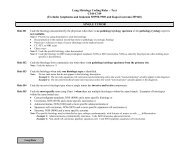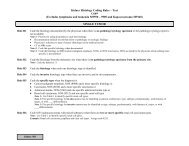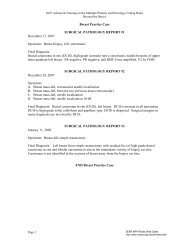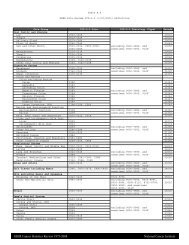Self Instructional Manual for Cancer Registrars - SEER - National ...
Self Instructional Manual for Cancer Registrars - SEER - National ...
Self Instructional Manual for Cancer Registrars - SEER - National ...
You also want an ePaper? Increase the reach of your titles
YUMPU automatically turns print PDFs into web optimized ePapers that Google loves.
Abstracting the Pathology Report<br />
Let us now examine the following pathology reports (G2-GS). A number of important<br />
features of these reports are given below:<br />
a. The date of the report. This date should coincide with the date of the corresponding<br />
operative report, not the date the slides were read nor the date of dictation.<br />
b. A short clinical history of the patient. This in<strong>for</strong>mation describes the reasons why the<br />
tissue was removed.<br />
c. In the space labeled "pre-operative diagnosis" or _elinical diagnosis" will be a brief<br />
description of the diagnosis as based on the physical examination and/or on a<br />
statement provided by a referring physician.<br />
d. The "gross description" of the report will contain a description of the material<br />
received <strong>for</strong> examination and will include the source of the specimen. The size of<br />
tissue fragments taken at biopsy and how they are received and the size of the<br />
surgical specimen are not important to the abstraetor and should not be reported, but<br />
if the tumor size is given it should be recorded.<br />
e. The "microscopic description" of the report contains the pathologist's description of<br />
the specimen(s) examined. Of special significance is the total size of the tumor, and<br />
where it has extended or metastasized. Size will usually be reported in centimeters<br />
(cm), and often the length, breadth, and thickness of the tumor will be given. The<br />
abstractor need only report the largest dimension of the tumor. If there is a<br />
discrepancy between the microscopic and gross description of the excised tumor, the<br />
microscopic takes precedence.<br />
f. The "diagnosis" section will summarize the microscopic findings <strong>for</strong> each specimen<br />
examined. The diagnosis confirms or denies gross findings of malignancy, giving the<br />
histologic type of the cancer and, in some instances, giving the grade of the cancer<br />
(the degree to which the malignant cells have lost their normal configuration).<br />
g. Complete excision of the tumor may also be confirmed or denied by describing<br />
whether or not surgical margins are clear of tumor. This most often appears in the<br />
microscopic, but may be found in the final diagnosis.<br />
201

















